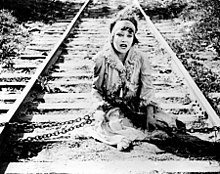
Our Town is a three-act play written by American playwright Thornton Wilder in 1938. Described by Edward Albee as "the greatest American play ever written", it presents the fictional American town of Grover's Corners between 1901 and 1913 through the everyday lives of its citizens.

John Augustin Daly was one of the most influential men in American theatre during his lifetime. Drama critic, theatre manager, playwright, and adapter, he became the first recognized stage director in America. He exercised fierce and tyrannical control over all aspects of his productions. His rules of conduct for actors and actresses imposed heavy fines for late appearances and forgotten lines and earned him the title "the autocrat of the stage." He formed a permanent company in New York and opened Daly's Theatre in New York in 1879, and a second one in London in 1893.

Jan Miner was an American actress best known for her role as the character "Madge", the manicurist in Palmolive dish-washing detergent television commercials beginning in the 1960s.
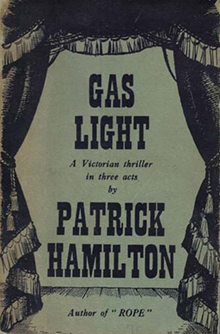
Gas Light is a 1938 thriller play, set in 1880s London, written by the British novelist and playwright Patrick Hamilton. Hamilton's play is a dark tale of a marriage based on deceit and trickery, and a husband committed to driving his wife insane in order to steal from her.

Charles Henry Pywell Daniell was an English actor who had a long career in the United States on stage and in cinema. He came to prominence for his portrayal of villainous roles in films such as Camille (1936), The Great Dictator (1940), Holiday (1938) and The Sea Hawk (1940). Daniell was given few opportunities to play sympathetic or 'good guy' roles; an exception was his portrayal of Franz Liszt in the biographical film of Robert and Clara Schumann, Song of Love (1947). His name is sometimes spelled "Daniel".
Robert Cuccioli is an American actor and singer. He is best known for originating the lead dual title roles in the musical Jekyll & Hyde, for which he received a Tony Award nomination and won the Joseph Jefferson Award, the Outer Critics Circle Award, the Drama Desk Award, and the Fany Award for outstanding actor in a musical.

Louis Aldrich, né Salma Lyon, was a stage actor who later became president of the Actors' Fund of America.

Rose Eytinge was a Jewish American actress and author. She is thought to be the first American actress to earn a three figure salary.

The Life and Adventures of Nicholas Nickleby is an 8½ hour-long adaptation of Charles Dickens’ 1839 novel, performed in two parts. Part 1 was 4 hours in length with one interval of 15 minutes. Part 2 was 4½ hours in length with two intervals of 12 minutes. It was originally presented onstage over two evenings, or in its entirety from early afternoon with a dinner break. Later it was presented on television over four evenings.

The Irish Repertory Theatre is an Off-Broadway theatre company founded in 1988.
Jennie Worrell was a burlesque actress of the 19th century from Cincinnati, Ohio. She was the youngest of three Worrell sisters who appeared in Broadway productions from 1867 to 1872.

Minnesota Centennial Showboat was a traditional riverboat theatre docked at Harriet Island Regional Park on the banks of the Mississippi River in downtown Saint Paul, Minnesota, United States. The showboat contained an intimate jewelbox theatre that seated 225. The interior was decorated to keep in time with the Victorian Era style commonly associated with showboats. The Minnesota Centennial Showboat was run through a partnership with the University of Minnesota Theatre Department and the Padelford Boat Company. The showboat was a longtime tradition with the University beginning in 1958. The University Theatre utilized the showboat as a learning opportunity for its students to experience professional theatre. The showboat had its final performance in 2016.
David Wohl is an American theater, television and film actor. He is a long time character actor.

Jessie Busley was an American actress and comedian who performed on stage, screen, and radio for over six decades.

Seven Keys to Baldpate is a 1913 play by George M. Cohan based on a novel by Earl Derr Biggers. The dramatization was one of Cohan's most innovative plays. It baffled some audiences and critics but became a hit, running for nearly a year in New York, another year in Chicago and receiving later revivals; Cohan starred in the 1935 revival. Cohan adapted it as a film in 1917, and it was adapted for film six more times, and later for TV and radio. The play "mixes all the formulaic melodrama of the era with a satirical [farcical] send-up of just those melodramatic stereotypes."
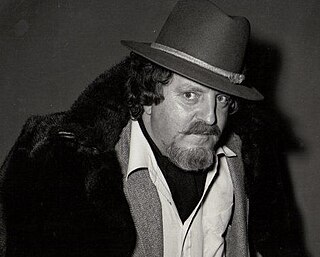
G. William "Bill" Oakley, Jr. was a theatrical producer-director-actor and seminal figure in the revival of early American theater, melodrama and vaudeville with theaters in Colorado and Missouri.
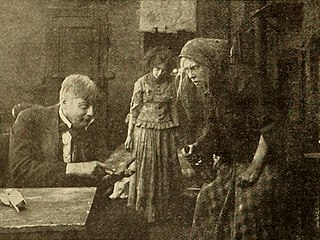
Under the Gaslight is a 1914 American silent melodrama film produced by the Biograph Company, for theatrical impresarios Klaw & Erlanger, and distributed by The General Film Company. It is based on the old Victorian stage melodrama of the same name by Augustin Daly popular in the 1860s and 1870s and revived periodically for years afterwards. This film was directed by Lawrence Marston and stars Lionel Barrymore.

The Show-Off is a 1924 stage play by George Kelly about a working-class North Philadelphian family's reluctance to accept their daughter's suitor Aubrey Piper, an overly confident Socialist buffoon. The play has been revived five times on Broadway and adapted for film four times; it is Kelly's most frequently produced play.

Olympic Theatre was the name of five former 19th and early 20th-century theatres on Broadway in Manhattan and in Brooklyn, New York.
Diplomacy is an 1878 English play which is a translation and adaptation by B. C. Stephenson and Clement Scott of the 1877 French play Dora by Victorien Sardou. It saw frequent revivals and was a popular play for over fifty years.
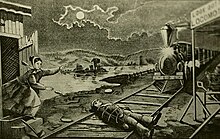

!["Barney Oldfield's A Race for a Life" [1913] with left to right:Hank Mann; Ford Sterling; Al St John and in foreground Mabel Normand Barney Oldfield's Race for a Life.jpg](http://upload.wikimedia.org/wikipedia/commons/thumb/0/01/Barney_Oldfield%27s_Race_for_a_Life.jpg/180px-Barney_Oldfield%27s_Race_for_a_Life.jpg)
